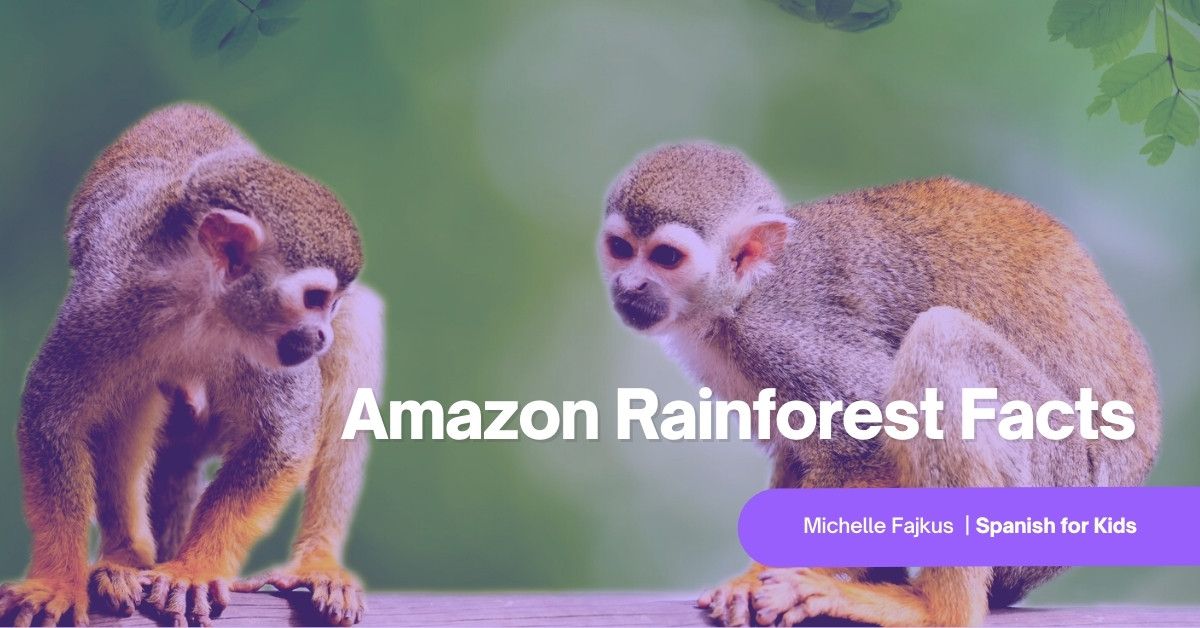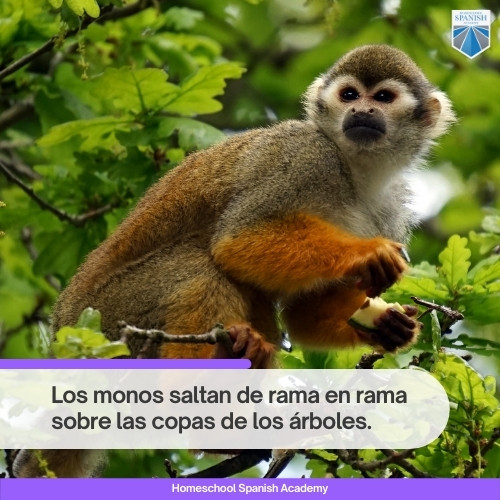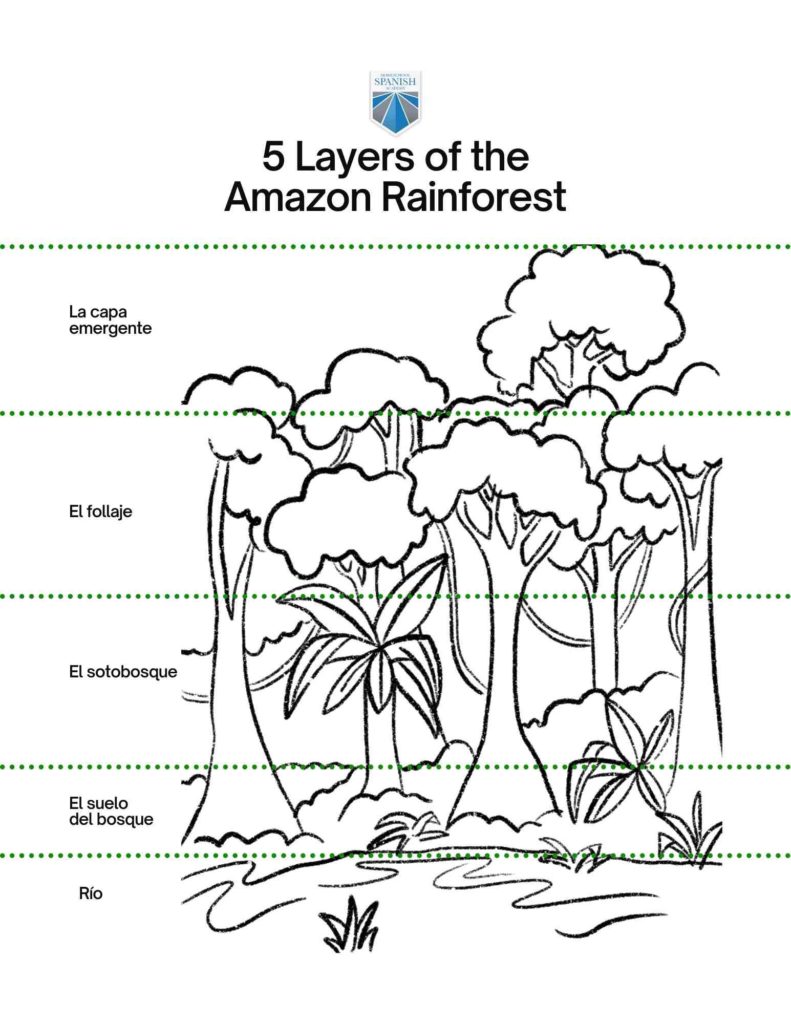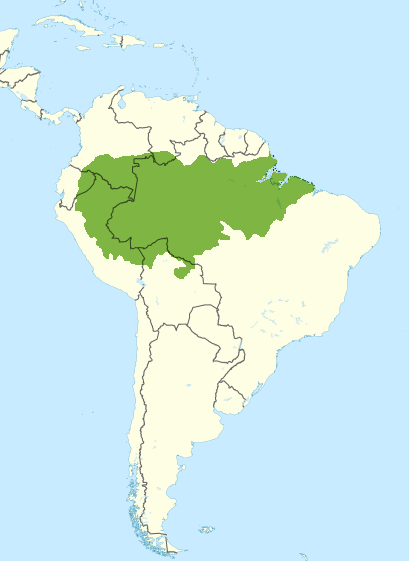
Amazon Rainforest Facts (Free Spanish Lessons for Kids)
Teaching kids about the Amazon rainforest in Spanish inspires them to explore geography, culture, and language.
How big is the Amazon rainforest? Well, it’s the largest tropical forest on the planet. The Amazon rainforest covers vast areas of six countries, Venezuela, Colombia, Ecuador, Peru, Brazil, and Bolivia. In fact, it encompasses about 40% of South America!
Si la Amazonia fuera un país, sería el noveno más grande del mundo.
If the Amazon were a country it would be the 9th largest in the world.
La selva amazónica alberga 1,400 millones de acres de bosques densos, la mitad de los bosques tropicales que quedan en la Tierra.
The Amazon rainforest is home to 1.4 billion acres of dense forests, half of Earth’s remaining tropical forests.
Keep reading for a super fun, kid-centered Spanish-learning guide that teaches vocabulary related to the Amazon Rainforest!

Download FREE Amazon Rainforest in Spanish Activities for Kids!
Type your name and email below to get four activities for kids about the Amazon Rainforest in Spanish! You will receive: -Flashcards -Word Search -Coloring Pages
Explore more FREE SPANISH LESSONS FOR KIDS! ➡️
Enjoy over 70 unique lessons + free activity packets to download.
Amazon Rainforest Animals
Which animals live in the Amazon rainforest? This amazing place is home to an abundance of creatures, giving it an extraordinary level of biodiversidad (biodiversity). Scientists are discovering new species in the Amazon all the time.
La Amazonia has some of Earth’s most awesome animales tropicales (tropical animals). It’s time to learn their names in Spanish!
Mammals (Los mamíferos)
Mammals are warm-blooded animals with fur that give birth to live young.
| English | Spanish |
| anteater | el oso hormiguero |
| bat | el murciélago |
| lemur | el lémur |
| leopard | el leopardo |
| jaguar | el jaguar |
| monkey | el mono |
| tiger | el tigre |
| sloth | el (oso) perezoso |
Example Sentences in Spanish
Los monos saltan de rama en rama sobre las copas de los árboles.
Monkeys leap from branch to branch in the tree canopy.
Los jaguares agraciados miran y esperan a sus presas.
Graceful jaguars watch and wait for their prey.

Birds (Las aves)
Gorgeous tropical birds add color to the Amazonian treetops and the sky.
| English | Spanish |
| eagle | el águila |
| flamingo | el flamenco |
| golden tanager | la tangara dorada |
| parakeet | el periquito |
| parrot | el loro |
| scarlet macaw | la guacamaya roja |
| toucan | el tucán |
Example Sentences in Spanish
Los loros coloridos vuelan de árbol en árbol.
Colorful parrots fly from tree to tree.
Los flamencos comen algas y camarones.
Flamingos eat algae and shrimp.
Reptiles (Los reptiles)
Reptiles are fascinating cold-blooded creatures and an important part of the Amazon forest ecosystem.
| English | Spanish |
| boa constrictor | la boa |
| caiman | el caimán |
| iguana | la iguana |
| lizard | el lagarto |
| snake | la culebra |
| tree frog | la rana de árbol |
Example Sentences in Spanish
La boa es un tipo de culebra tropical.
The boa constrictor is a kind of tropical snake.
Culebras silenciosas cuelgan de las enredaderas.
Silent snakes hang from the vines.
Insects (Los insectos)
Many exotic insects live in the Amazon rainforest. Let’s go over a few of their names in Spanish!
- ant – la hormiga
- beetle – el escarabajo
- butterfly – la mariposa

Explore more FREE SPANISH LESSONS FOR KIDS! ➡️
Enjoy over 70 unique lessons + free activity packets to download.
Example Sentences in Spanish
Las mariposas se alimentan del néctar que producen las flores en la selva.
Butterflies feed on the nectar that flowers in the rainforest produce.
Los escarabajos titán pueden crecer hasta 7 pulgadas de largo.
Titan beetles can grow up to 7 inches long.
5 Layers of the Amazon Rainforest
There are five layers of the Amazon rainforest. Different plants and animals live on each level or layer. Some animals move up and down from one layer to the next.
Let’s explore the rainforest layers!

1. River (El río)
The lowest layer of the Amazon rainforest is the Amazon River. It’s the largest river in the entire world. Here you’ll find animals that swim and eat food found in the water.
¿Cuáles animales crees que viven en el río Amazonas?
What animals do you think live in the Amazon River?
2. Forest Floor (El suelo del bosque)
The next layer of the rainforest is the suelo del bosque (forest floor). The forest floor is the ground, and it’s covered with leaf litter.
Animals that can’t climb well and like to dig live on the forest floor. Due to the poor quality soil, few plants and vine roots take root in the forest floor.
3. Understory (El sotobosque)
Trees, bushes, and vines grow in the dark and quiet sotobosque (understory). Animals that climb well and nest in the tree trunks live in the understory.
The understory is full of vines, shrubs, and broadleaf trees. This layer provides camouflage to many of the species who live here.
4. Canopy (El follaje)
The tops of the trees in the rainforest are called the follaje (canopy). The canopy is ideal for animals that climb well, eat leaves, fruits, and nuts, and like to hide among the leaves.
The canopy consists of a thick layering branch system of limbs that form a natural umbrella. This layer absorbs ultraviolet rays from the sun and retains moisture. It acts as a shield during the daily downfalls of the rainy season.
5. Emergent Layer (La capa emergente)
The uppermost layer of the rainforest is the capa emergente (emergent layer). It’s bright, sunny, and spacious. Animals that fly, have excellent balance, and are avid climbers live here.
Many bat, butterfly, and monkey species seek food and shelter in the emergent layer. For them, it’s a safe refuge from the many forest predators.
Here’s an Amazon rainforest map:

Deforestation and Climate Vocabulary
La deforestacíon (deforestation) is the destruction of trees. Another way to say it is la destrucción de los árboles (destruction of the trees).
Over the past four decades, people have cut down almost 20% of the Amazon rainforest. This causes the loss of habitat for species and worsens the effects of cambio climático (climate change).
The destruction of the priceless Amazon rainforest negatively impacts our planet. It speeds up the effects of calentamiento global (global warming).
Every time a tree is cut down, it releases carbon dioxide into the atmosphere and it is no longer able to absorb the carbon dioxide released by human activity.
This video shows the giant Amazon Rainforest fire from 2019.
More Amazon Rainforest Learning Activities in Spanish
The Amazon is a rich and exciting topic for children to study in any language. Check out the following book, song, arts and crafts, and video recommendations to teach your children or students about the Amazon rainforest in Spanish!
Spanish Books about the Amazon Rainforest
Many beautiful Spanish language books about the rainforest are available for kids (on Amazon).
Here is a selection.
- De paseo por la selva (On a Walk in the Jungle)
- Cha-cha-cha en la selva (Cha-Cha-Cha in the Jungle)
- Un recorrido por la selva (A Trek Through the Jungle)
- El gran capoquero – Un cuento de la selva Amazónica (The Great Kapok Tree: A Tale of the Amazon Rainforest)
- La selva amazónica (Amazon Rainforest)
- La Tia en la Selva Amazónica: Una Verdadera Historia de Aventura y Libra para Colorar (Aunt in the Amazon: A True Adventure Coloring Book Story)
Spanish Songs about the Amazon Rainforest
Fun and interactive Spanish songs about animals that live in the rainforest abound.
- La guacamaya (macaw) by Spanish Together
- La iguana y el perezoso (the iguana and the sloth) by Canticuentos
- Animales de la selva (jungle animals)
- Pica-Pica – Cuando yo a la selva fui (when I went to the Jungle) by Pica-Pica
- El bugui de la selva (jungle boogie)
Amazon Rainforest Videos
Looking at video and photos gives kids a better sense of what the Amazon rainforest is really like.
- Lola Aventuras – En el corazón de la selva (Lola’s adventures, in the heart of the jungle). Lola (of Sesame Street) travels to la selva Amazónica in Colombia. The episode focuses on how all animals have hearts and uses the animals of the rainforest as examples.
- Un viaje a la selva para los más chiquitos (a trip to the jungle for the littlest ones). This video introduces kids to the rainforest using repetition of key words and video footage of animals.
- Jorge el Curioso | La aventura de Jorge en el Amazonas (Curious George, Adventure in the Amazon).
- Los 30 animales del Amazonas más increíbles y bellos (the 30 most incredible and beautiful animals of the Amazon). This 20-minute video is best for intermediate to advanced Spanish students.
Let’s Talk about the Amazon Rainforest in Spanish
The best way for your kids to retain this Amazon rainforest vocabulary is by using it! Spanish opens doors for your children’s future. It helps them develop strong listening, speaking, writing, and reading skills.
Becoming a confident and fluent Spanish speaker is easy for kids. It’s proven that children have the ability to acquire language skills more quickly and naturally than adults. The sooner they are exposed to Spanish, the faster they’ll learn it.
So, don’t hesitate—sign your child up for a free trial class with one of our friendly, certified, native Spanish teachers at Homeschool Spanish Academy today!

Want more free Spanish lessons, fun content, and easy learning strategies for kids? Check these out!
- Is Your Child on Track? Check their Spanish Language Proficiency by Age Group
- Screen-Free Spanish Fluency Games That Actually Work
- Fun Spanish Fluency Games for Road Trips and Grocery Runs
- How to Create a Daily Homeschooling Routine Using Spanish Fluency Games for Kids
- Boost Your Child’s Spanish Skills with These Family-Friendly Games
- How to Help Your Child Speak Spanish with Confidence (Without Feeling Embarrassed!)
- The Best Spanish Learning Podcasts for Kids
- Spanish for Middle Schoolers: The Perfect Age to Start (Here’s Why!)
- Ver Conjugation: Free Spanish Lesson, Exercises, and PDF - December 5, 2024
- What Are the Different Levels of Language Proficiency? - October 17, 2024
- Master All the Forms of Ser in Spanish: Your Ultimate Grammar Guide - July 18, 2024




